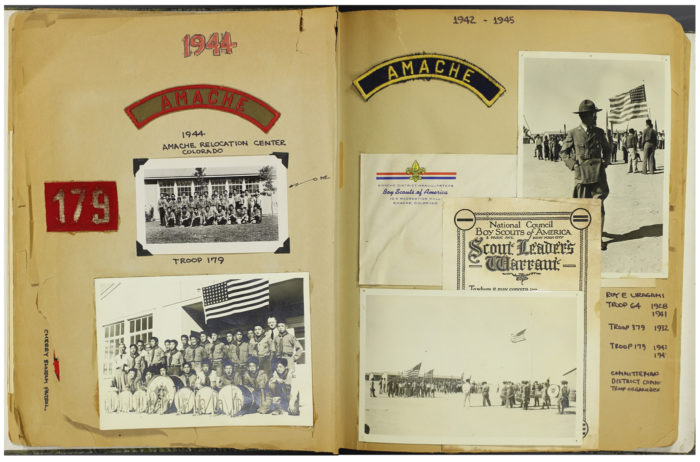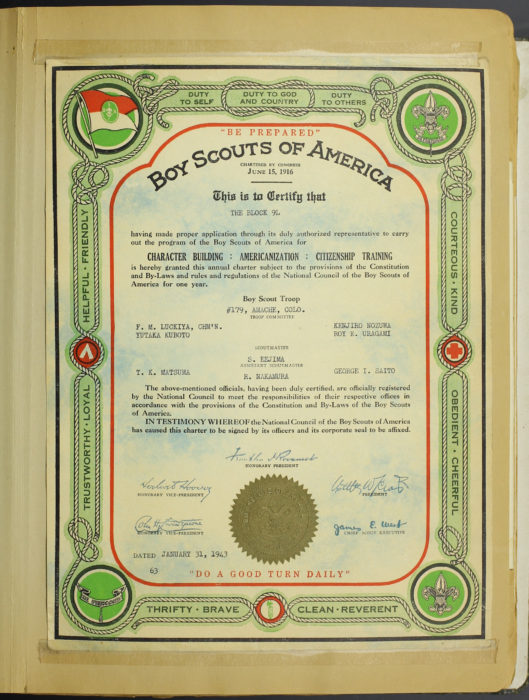Scouts in Camp

Japanese American National Museum, Gift of Robert and Rumi Uragami (2003.86.1)
Click to open full-size image in new tab.These are two pages from a 73-page scrapbook documenting three generations of boy scouting in a Japanese American family. The scrapbook was made by Bob Uragami, whose father, Roy, was the first to become involved with scouting; Roy was followed by Bob, and later Bob’s son, Tim.
Look closely at these two pages.
- What do you recognize?
- What things do you wonder about?
- Where were these items used and when were these photographs taken?
- As you look at the photographs, what stands out to you?
- Why do you think Bob decided to include these specific photographs and mementos in his scrapbook?

Japanese American National Museum, Gift of Robert and Rumi Uragami (2003.86.1)
Click to open full-size image in new tab.This Boy Scouts of America certificate was given to the Boy Scout troop of Japanese Americans incarcerated at Amache, Colorado. Look closely at the text and designs on this certificate.
- How would you describe the overall tone of this certificate?
- Which words stand out to you?
- How would you have felt if you received this certificate from the Boy Scouts of America while you were imprisoned by the US government?
- How might words such as “duty to country” and “Americanization” feel different to the members of this troop under the conditions in which they lived?
Bob Uragami video interview, Japanese American National Museum
Click to open full-size image in new tab.In this video, Bob Uragami speaks about the drum that was used by his Boy Scout troop while incarcerated at Amache. The drum can also be seen in one of the images in the scrapbook. As you watch this video, consider what Mr. Uragami says about the flags depicted on the drum.
When he refers to the “meatball,” he is using a nickname for the Japanese flag, which has one large circle on it.
- How does the story about the flags reflect the identity of this group of Boy Scouts?
- How does the story about the burial suit reflect the identity of Mr. Uragami’s father?

Japanese American National Museum, Gift of Robert and Rumi Uragami (99.2.8B)
Click to open full-size image in new tab.- What do you see depicted in this image?
- Who do you think the man in the foreground is?
- Where do you think this photograph was taken?
- What evidence in the photograph helps you draw these conclusions?
This photograph was taken at Amache Concentration Camp. Roy Uragami, the father of Bob Uragami, is pictured in his uniform in the foreground.
- How would you describe Roy Uragami’s expression?
- What thoughts might be going through his head at this moment?

Japanese American National Museum, Gift of Robert and Rumi Uragami (2003.86.1)
Click to open full-size image in new tab.Objects can tell us a lot about the people who use them. The scrapbook, the Boy Scouts of America certificate, the drum, and the photograph of Roy Uragami in uniform all convey a sense of patriotism.
Bob Uragami kept memorabilia and photographs from his time as a Boy Scout in Amache. He was a young American and proud to belong to the Boy Scouts of America even at a time when the United States, by incarcerating Japanese Americans, was telling him that he did not belong. The fact that Mr. Uragami chose to keep these things shows that the items reflect an important part of his identity—his past as an American kid who participated in ordinary American activities during a very unordinary time. Through these artifacts, we see how a bicultural Japanese American identity was created within the concentration camp.
Return to Identity
